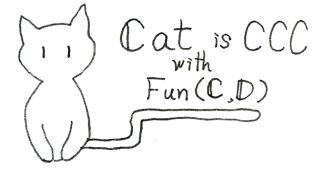
Related page : short explanation of Awodey's "Category theory"

 This book seems to aim a rapid study of category theory.
It is relatively short (183 pages, 107 exercises).
After some basic definitions, it goes to the chapter of "Adjoints", from the
very first (The chapter of "Adjoints" is the second from the last in
Awodey's Category Theory). This book contains plenty of examples.
So, if you are familiar to those examples, this book is relatively easy to
understand. Another feature is that the author seems to try to tell
the background ideas or naiive images in several ways. If those effort
reaches to your mind,
this book will be suitable for you and valuable.
This book seems to aim a rapid study of category theory.
It is relatively short (183 pages, 107 exercises).
After some basic definitions, it goes to the chapter of "Adjoints", from the
very first (The chapter of "Adjoints" is the second from the last in
Awodey's Category Theory). This book contains plenty of examples.
So, if you are familiar to those examples, this book is relatively easy to
understand. Another feature is that the author seems to try to tell
the background ideas or naiive images in several ways. If those effort
reaches to your mind,
this book will be suitable for you and valuable.
Any way, it would be good that you once skim the whole contents. You can judge whether you can read the book. If you cannot, the terminologies and concepts that jumped in your eyes will help your study of category theory when you study it in in another book.
You can get its PDF of the arXiv version from
Tom Leinster : Basic Category Theory, 2014
(https://arxiv.org/abs/1612.09375)
The structure of the book is as follows. After the definition of the basic concepts and terminologies, three main topics, that is, "Adjoints", "Representables", "Limits", are explored. Just before the second topics, "Representable" which is deeply related the set theory, "Interlude on sets" is placed. After the three topics, at the last chapter, the relation between the three topics are explained.
By the way, I binded the printed material like this by myself and bring it in my bag. This is the picture of the self-made book in open form. I can mark the texts and write comments as I like. It provides a pleasant learning environment. If you are interested in binding a book by yourself, I wrote the method at here (written in Japanese).
The PDF of all the figure in this page is
The PDF of the short explanations in this pageI will modify the file when I post new ones.
In this chapter, we study basic concepts and terminologies of category theory. You may feel a little difficulty to understand "Natural transformation". But, since it is very important concept, please get accustomed to it by looking many examples, drawing pictures many times, etc..
Adjoints are two categories with two functors each of which goes from one to the other, and satisfy some conditions. Those categories and functors constrain each other and share a certain common structure. In this chapter, after the definition, we meet a lot of examples and two more characterizations of the adjoints which are equivalent to the first definition and have their own intuitions. The author says "Adjoints are both common and easy. Knowing them will add a very useful tool to your mathematical toolkits."
Chapter 3 is an interude on sets. Does "Interlude" mean that we can read this chapter comfortably?
The reasoin this interlude occupies here is that we study representables next chapter. representables are functors that map an object in a category into a set. Therefor, we study necessary knowledge about sets here.
There are three topics in this chapter.
The first section is to express the fundamental properties of sets in terms of category theory. In mathematics, we often use a relatively higher level properties of sets, such as, making direct products, direct sums, the set of all function from a set to another set, etc, rather than the basic membership relation. In this chapter, those, a little higher level, properties of sets are formulated in the terms of category.
The second section introduces the difference of collection sizes, small and large. Perhaps, you know if we assume the set of all sets, we meet a contradiction. The set of all sets is too big. In this section, the sizes of collections, "small" and "large" are introduced. They are used in the latter chapters.
The third section is the historical story of set theory, Cantor set theory, Types, Membership-based set theory (ZFC), Set theory today, and some comments. While the contents of this section is not necessary for the latter chapters, they provide the readers useful perspective.
At last, I had no ideas of an illustration and a joke for the summary figure of this chapter. This chapter relates to the foundation of mathematics. Long long ago, I was taught that I should be very polite in the foundation. So, the conversation of the two students seems unnatural. The talk about the scientific fiction by Isaac Asimov.
A category is a world of objects looking at one another. Each sees the world from a different viewpoint. Examples of viewpoints are shown as a table. For example, in the category of topological spaces Top, the set of real numbers R sees a curve in another topological space X (It would be more precise to say "An object sees its image in another object). Dual viewpoints are also possible. These lead us to the theory of representables naturally.
We will study the thrid approach to the Universal Property. In mathematics, a construction of new object from objects and maps often involves taking limit/colimit of those objects and maps. We study the definition of the limits/colimits and see their examples.
This is the last chapter. Here, the relation between the three approaches to the unversal propety, i.e., Adjoints, Representables, and Limits/Colimits is explored. Basically, anything which is described in one of these formalisms can be also described in another formalism.
This chapter explains more than the equivalence of these formalisms. The highlights are (the numbers are put as (1) to (5) as the order of the highlights in the front page of chapter 6)
No short explanations
No short explanations
Back to "Let's Study Category Theory"